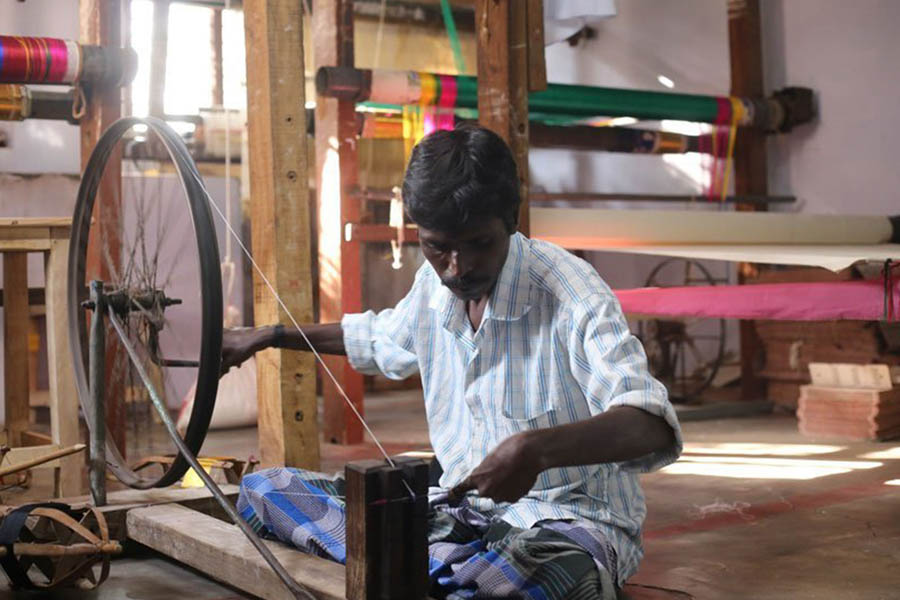Through the Looms…
A visual journey into the heart of Kanchipuram’s weaving heritage
Handloom weaving is an intricate art that demands patience, passion, creativity, and deep attention to detail. Every saree you drape carries countless hours of skill, effort, and devotion — especially the legendary weaves of Kanchipuram.
Through this photoblog, we take you inside the looms of the silk capital of India — Kanchipuram, capturing the unseen, painstaking efforts that bring to life the iconic Handwoven Kanjivaram Silk Sarees loved across generations.
1. Preparing the Loom
The journey begins long before a saree takes shape.
The loom must be prepared with precision and discipline.
Warping the yarn:
The yarn is wound meticulously onto a warp beam. It takes almost two full days to prepare and warp about 10,000 silk threads on a loom — the foundation of the saree.
2. Zari on the Beam
Zari yarns are drawn from wooden beams for warping.
Here, the weaver’s eyes do not leave the loom even for a moment. Each movement is a calculated step in creating authentic Traditional Kanjivaram Silk Sarees.
3. The Warp Beam Setup
Warp yarns are rolled onto an iron beam and secured at the back of the loom.
Every thread must fall into exact alignment — even one misplaced yarn can disrupt the pattern.
4. Joining Zari & Silk
In the traditional Korvai technique, the gold-coated zari thread is joined with silk by carefully twisting them together.
This fusion gives Kanjivarams their unmistakable lustre and durability, especially in Korvai Kanjivaram Silk Sarees.
5. Preparing the Weft
The weft silk hank is first stretched over a wooden stand.
The yarn is then wound onto sticks, which will be inserted repeatedly into the warp to build the saree’s body.
6. The Pit Loom
This is the heart of Kanchipuram weaving.
A pit is dug below ground level, and the loom stands above it. The pedals hang inside the pit, allowing the weaver to work with stability, rhythm, and long hours of focus.
7. The Art of Leg Work
The loom’s treadles control the up-and-down movement of heddles — the mechanism that separates warp yarns.
Every press of the pedal allows the weft thread to pass through the warp.
Fun fact:
A weaver uses his legs 17,920 times to weave just one saree.
This incredible labour is one reason classic weaves like Kanjivaram Silk Sarees are cherished for generations.
8. When Threads Break — Patience Begins
Warp threads snap frequently during weaving.
Each break must be repaired manually — joined carefully with the finest touch. This requires extraordinary patience, as the weaver cannot afford even a momentary lapse in concentration.
9. Time, Skill & Commitment
A single Kanjivaram saree can take anywhere from 3 to 4 weeks to complete.
Some complex designs take even longer. It is truly a labour-intensive craft — and a labour of love.
10. A City of Looms
Kanchipuram is home to over 20,000 looms, producing five lakh sarees every year.
Each loom is operated by 3 to 4 weavers, and some handloom styles require 6 artisans to create a single masterpiece.
11. The Saree Takes Shape
As weaving progresses, the completed portion of the saree is slowly rolled onto the front wooden beam.
Row by row, thread by thread, a timeless story begins to unfold.
12. The Magic of Jacquard
Intricate designs — motifs, temple borders, checks, florals, and pallus — emerge through the jacquard technique.
This is where the saree’s visual identity truly comes alive.
13. Handspun Beauty
Nothing compares to the charm of handspun silk.
Here, silk yarn is wound onto pirns (spools) using a hand-spinning charkha — a compelling reminder of India’s cherished handcrafted legacy.
14. A Lifetime of Dedication
A weaver’s commitment is beyond measure.
Over a 30-year career, a single weaver uses his limbs 18,360,000 times to create roughly 1,000 sarees — each one a masterpiece, each one a legacy.
Through the Looms, Lives a Heritage
Kanchipuram’s weaving tradition is not just craft — it is devotion, mathematics, endurance, and art.
Every weave carries the soul of the artisan and centuries of cultural pride.




